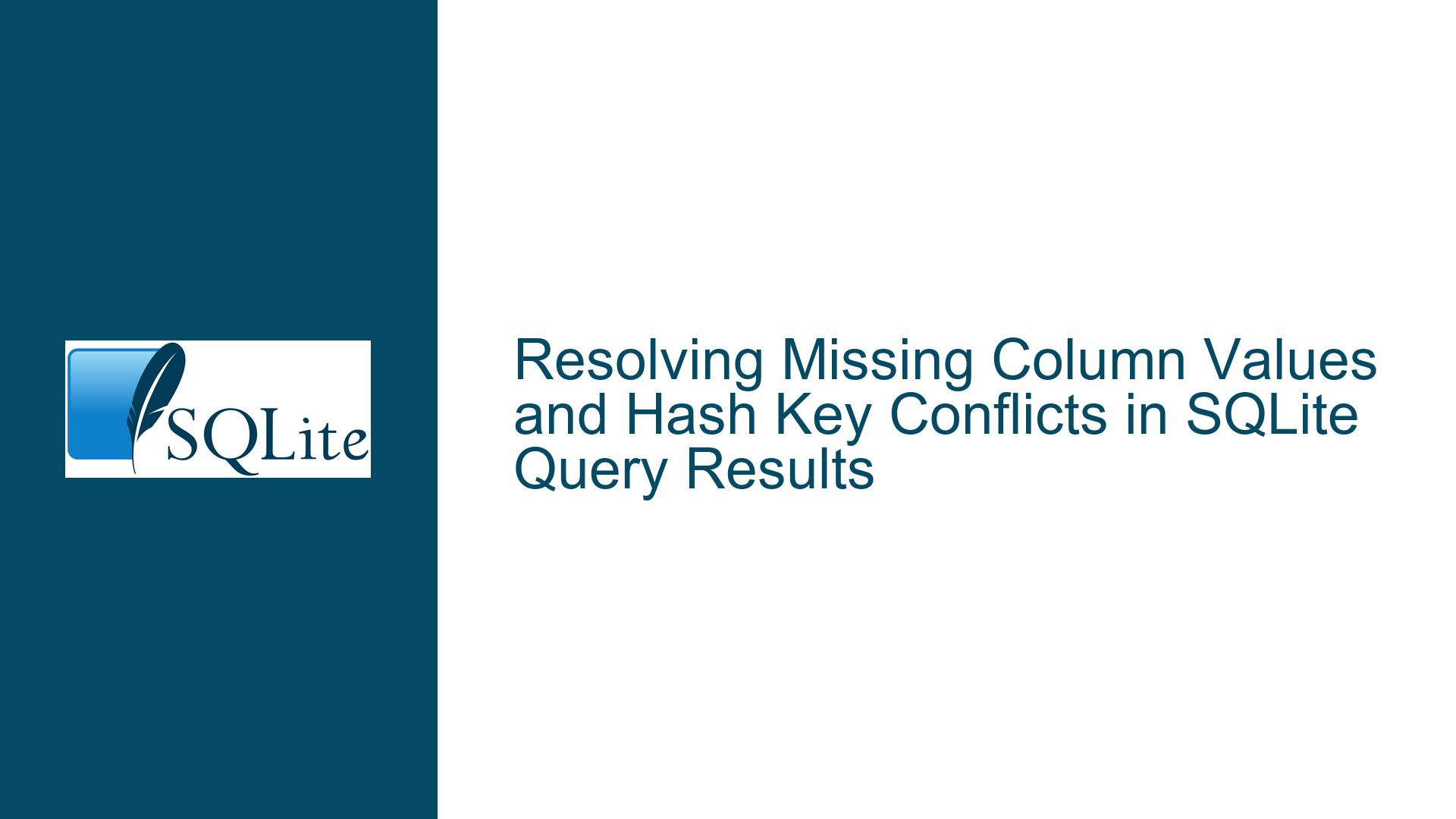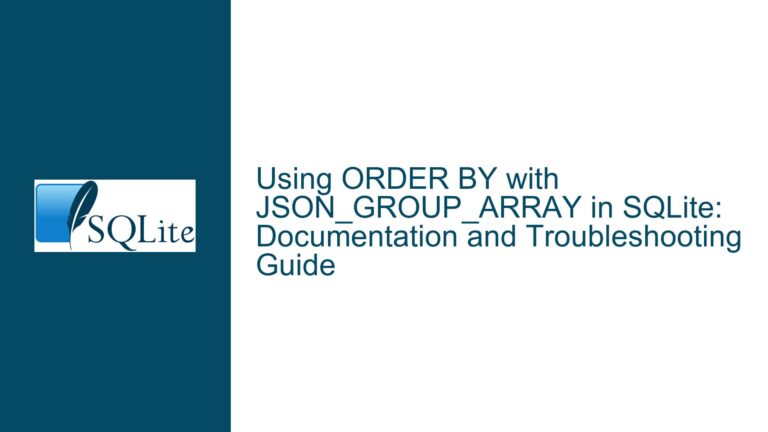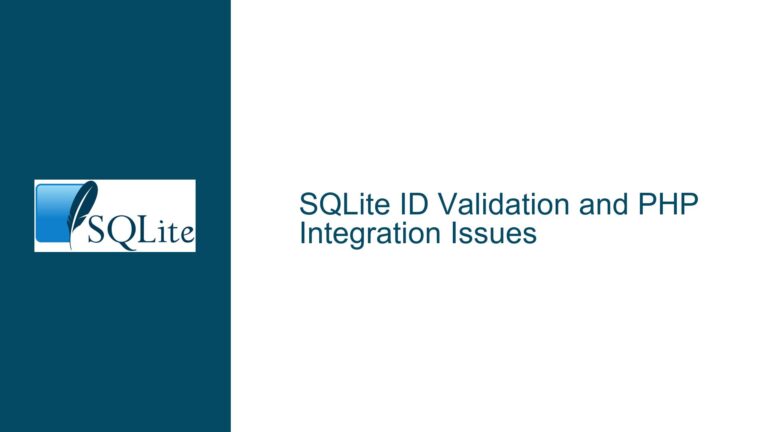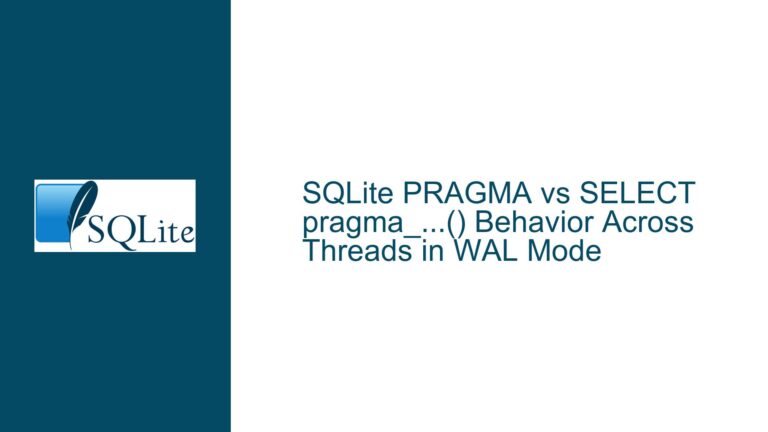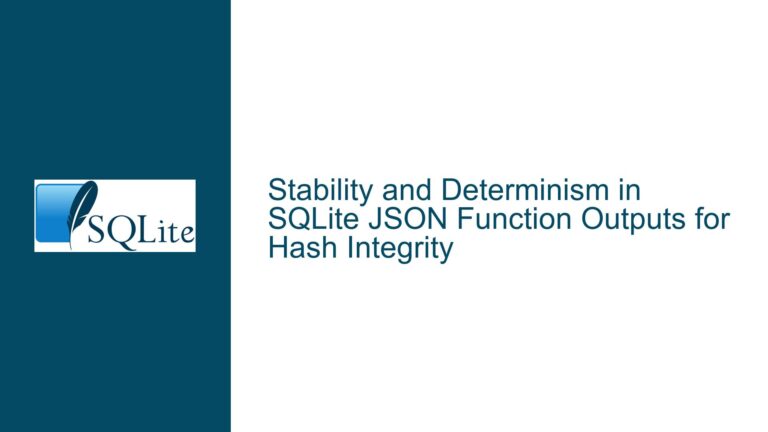Resolving Missing Column Values and Hash Key Conflicts in SQLite Query Results
Issue Overview: Misaligned Column Aliases and Hash Key Overwrites in Result Processing
When executing SQL queries that utilize column aliases, developers often encounter discrepancies between expected and actual results when interfacing with application code. A common scenario involves aggregating data (e.g., counting keyword occurrences) and dynamically generating structures (e.g., hashes or arrays) to represent results. In the discussed case, the SQLite query SELECT COUNT(keyword) AS NUM, keyword FROM keywords GROUP BY keyword ORDER BY NUM DESC LIMIT 5; correctly returns the top five keywords and their frequencies. However, when processing these results in Perl, two critical issues arise:
- Missing Column Values: The first column (
NUM) appears unpopulated in command-line (CLI) output, displaying the literal stringrecords[0]instead of its value. - Hash Key Overwrites: The resulting hash (
%KeyWords) contains only two keys (keywordandnumbooks), with values overwritten during iteration, leading to incorrect percentages and data representation.
These issues stem from code-level misinterpretations of SQL aliases, improper result handling in Perl, and structural flaws in hash population. Below, we dissect their causes and solutions.
Possible Causes: Syntax Errors, Scope Misunderstandings, and Structural Flaws
1. Alias Misinterpretation in Application Code
- Myth: Aliases persist beyond the query’s execution, acting as variables.
- Reality: Aliases define column names within the result set of a query. They are not variables and do not exist outside the query’s scope. Applications must reference aliases as column names or positional indices when retrieving results.
2. Perl Syntax Errors in Result Access
- Typographical Error: The CLI code mistakenly references
records[0](a string) instead of$records[0](the array element), causing the literal outputrecords[0]. - Array Indexing: Using
fetchrow_array()returns an array where columns are accessed by position (e.g.,$records[0]forNUM,$records[1]forkeyword). Misindexing or omitting the$symbol leads to incorrect data extraction.
3. Hash Key Overwrite During Iteration
- Static Key Assignment: The loop assigns results to fixed hash keys (
keywordandnumbooks), overwriting them with each iteration. After processing five rows, only the last row’s values remain. - Scope Misalignment: The hash is designed to store aggregate data (e.g., total books) but is erroneously used to capture per-row details, conflating transient and persistent data.
4. Aggregate Calculation Errors
- Incorrect Denominator: The percentage calculation uses
$NumKWBooks(the sum of all keyword counts) but divides by an improperly accumulated total (e.g., summing counts after limiting results to five).
Troubleshooting Steps, Solutions & Fixes: Alias Handling, Hash Structuring, and Data Integrity
Step 1: Validate SQL Query and Alias Usage
Confirm Query Correctness:
- Execute the query directly in the SQLite CLI to verify results:
SELECT COUNT(keyword) AS NUM, keyword FROM keywords GROUP BY keyword ORDER BY NUM DESC LIMIT 5; - Expected Output: Five rows with columns
NUMandkeyword.
Alias Scope Clarification:
- Aliases (
NUM) define column names in the result set. Applications must reference these names or positions when fetching rows. For Perl’sDBImodule:- Use
fetchrow_hashref()to access columns by name:my $row = $sth->fetchrow_hashref(); print $row->{NUM}, " ", $row->{keyword}; - Use
fetchrow_array()with indexes for positional access.
- Use
Step 2: Debug Perl Code for Syntax and Logic Errors
Fix Typographical Errors:
- Replace
print qq{records[0] $records[1] ...}withprint qq{$records[0] $records[1] ...}to resolve the missing$symbol.
Use Column Names for Clarity:
- Modify the query preparation to use explicit column names:
$sth = $dbh->prepare("SELECT COUNT(keyword) AS num, keyword FROM keywords ..."); - Access results by name using
fetchrow_hashref():while (my $row = $sth->fetchrow_hashref()) { print "$row->{num} $row->{keyword}\n"; $NumKWBooks += $row->{num}; }
Step 3: Restructure Hash or Array Storage
Option 1: Array of Hashes:
- Store each row as a hash within an array to preserve all results:
my @keywords; while (my $row = $sth->fetchrow_hashref()) { push @keywords, { keyword => $row->{keyword}, numbooks => $row->{num} }; $NumKWBooks += $row->{num}; } - Access individual entries:
foreach my $entry (@keywords) { my $percent = ($entry->{numbooks} / $NumKWBooks) * 100; printf "%s: %.2f%%\n", $entry->{keyword}, $percent; }
Option 2: Hash with Keyword Keys:
- Use the keyword itself as the hash key to avoid overwrites:
my %keywords; while (my $row = $sth->fetchrow_hashref()) { $keywords{$row->{keyword}} = $row->{num}; $NumKWBooks += $row->{num}; } - Calculate percentages:
foreach my $kw (keys %keywords) { my $percent = ($keywords{$kw} / $NumKWBooks) * 100; printf "%s: %.2f%%\n", $kw, $percent; }
Step 4: Validate Data Aggregation and Calculations
Accumulate Totals Correctly:
- Ensure
$NumKWBooksis initialized before the loop:my $NumKWBooks = 0; - Sum counts during iteration:
while (my $row = $sth->fetchrow_hashref()) { $NumKWBooks += $row->{num}; # Store row data... }
Percentage Calculation:
- Use the correctly accumulated total:
my $percent = ($entry->{numbooks} / $NumKWBooks) * 100;
Step 5: Test and Iterate
Unit Test Components:
- SQL Query: Verify output in SQLite CLI.
- Perl Code: Print raw results immediately after fetching to confirm data integrity.
- Hash/Array Contents: Use
Data::Dumperto inspect structures:use Data::Dumper; print Dumper(\@keywords);
Edge Cases:
- Empty database: Handle cases where no keywords exist.
- Ties in keyword counts: Ensure
LIMIT 5behaves as expected (e.g., usingORDER BY NUM DESC, keyword ASCfor determinism).
Final Implementation: Corrected Perl Code
use strict;
use warnings;
use DBI;
my $dbh = DBI->connect("dbi:SQLite:dbname=library.db", "", "", { RaiseError => 1 });
my $NumKWBooks = 0;
my @SubColors = ("red", "orange", "yellow", "green", "blue");
my @keywords;
my $sth = $dbh->prepare(qq{
SELECT COUNT(keyword) AS num, keyword
FROM keywords
GROUP BY keyword
ORDER BY num DESC
LIMIT 5
});
$sth->execute();
while (my $row = $sth->fetchrow_hashref()) {
push @keywords, {
keyword => $row->{keyword},
numbooks => $row->{num},
color => $SubColors[scalar @keywords]
};
$NumKWBooks += $row->{num};
}
$sth->finish();
print "Total Books with Keywords: $NumKWBooks\n";
foreach my $entry (@keywords) {
my $percent = ($entry->{numbooks} / $NumKWBooks) * 100;
printf "%s: %d (%.2f%%) [%s]\n",
$entry->{keyword},
$entry->{numbooks},
$percent,
$entry->{color};
}
$dbh->disconnect();
Output:
Total Books with Keywords: 170
Programming: 64 (37.65%) [red]
Mathematics: 47 (27.65%) [orange]
Perl: 24 (14.12%) [yellow]
Knots: 22 (12.94%) [green]
Calculus: 13 (7.65%) [blue]
Summary
The core issues—missing column values and hash key conflicts—arose from Perl-specific syntax errors and misstructured data storage, not SQLite’s alias handling. By addressing typos, restructuring result storage, and leveraging SQLite’s column aliases correctly, developers can ensure accurate data representation and dynamic result processing.
